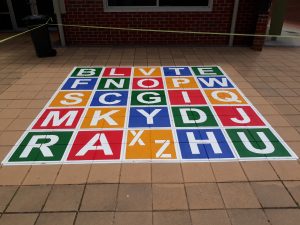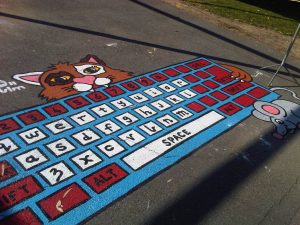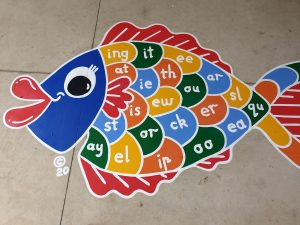For a lot of us, it’s hard to remember how we learnt to read and write. It’s a skill that’s become so instinctive, we barely even think about the fact that we do it.
But when we stop to consider just how much of what we do on a day-to-day basis relies on our ability to join letters together into a cohesive set of words, it’s easy to see just how important literacy is.
That is why we at Brighter Lines put so much effort into conceptualizing and creating playground art that not only looks nice, but inspires kids to learn and develop in their ability to read and write.
In this article, we want to show you three of our favorite literacy designs, and look at exactly how they impact the education of the students that use them.

1. Jumpaword
Jumpaword is a game of our own design. The concept is simple: jump between the colorful blocks to spell out different words. It might not seem like all that much, but the learning effect that games like this have is significant. The two key reasons for this are movement and memory.
Jumpaword requires specific movements to spell words. Rather than just trying to remember the order of letters in their minds, kids are able to orient themselves in physical space and jump from letter to letter to spell out words. This creates definitive memories. Instead of trying to recall a vague order of letters, students are able to call to mind a specific memory of them jumping between squares that ingrains the spelling of certain words.
It’s a really great addition to their learning experience.

2. Keyboard Art
While spelling and grammar are skills that can be transferred between all styles of writing, typing is its own unique skill. That’s why we at Brighter Lines offer a range of different Keyboard Art designs.
These designs have lots of great games that can be played with them, such as:
- Alphabet Jumble: Getting kids to jump from key-to-key in alphabetical order
- Spelling List: Using the keyboard to spell out words from the student’s spelling list
- The Number Keys: Using the numbers on the keyboards to solve simple math problems by jumping on the correct number/s before landing on “Enter”
Not only is it important for kids to understand letters, sounds and the way words are formed, but it is also vital that they are familiar with the layout and function of keyboards. The clearly marked ‘buttons’ on the design often inspires kids to invent their own games based on the artwork.
With this, kids are reinforcing their understanding of letters and typing by engaging with the artwork. They are also taking ownership and coming up with their own rules of play and through this, their understanding of the keyboard layout becomes concrete in their minds.
It’s a terrific outcome!

3. Phonic Designs
Phonic Designs, like the Sound Fish pictured above, are great ways of teaching young kids more complex literacy skills. More than learning letters and simple words, something like the Sound Fish helps students understand phonics; the unique sounds letters can make when put together.
It’s also a great example of how playground art can be used as a tool by teachers as part of a classroom lesson. Breaking up the norm of sitting indoors by heading to the playground for a game-based lesson is a wonderful way of keeping kids invested and interested while also providing a refreshing alternative for teachers.
Like the Jumpaword and Keyboard Art, Phonic Designs carry the same benefits of movement and memory, but in a way that’s more challenging (and rewarding) as they engage with more complex combinations of letters.
The fact that our artworks are able to get kid’s active, engaged and able to learn is one of the main reasons we love what we do.
If you’re interested in learning more about how our playground designs might be able to be integrated into your school, then please get in touch!
We’d love to have a chat about what we can do to help, and provide you with a fast, free, friendly quote.

